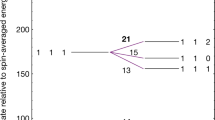Abstract
In the framework of a variational method, the molecular ion H +2 in a magnetic field is studied. The optimal form of the vector potential corresponding to a given magnetic field (gauge fixing) is chosen variationally. It is shown that for any magnetic field strength, as well as for any orientation of the molecular axis, the system (ppe) possesses a minimum in the potential energy. The stable configuration always corresponds to the elongation along the magnetic line. However, for magnetic fields B≳2×1011 G and some orientations, the H +2 ion becomes unstable, decaying into the H atom +p.
Similar content being viewed by others
References
B. B. Kadomtsev and V. S. Kudryavtsev, Pis’ma Zh. Éksp. Teor. Fiz. 13, 15 (1971) [JETP Lett. 13, 9 (1971)]; Pis’ma Zh. Éksp. Teor. Fiz. 13, 61 (1971) [JETP Lett. 13, 42 (1971)]; Zh. É ksp. Teor. Fiz. 62, 144 (1972) [Sov. Phys. JETP 35, 76 (1972)].
M. Ruderman, Phys. Rev. Lett. 27, 1306 (1971); in Proceedings of 53rd IAU Symposium on Physics of Dense Matter, Ed. by C. J. Hansen (Reidel, Dordrecht, 974), p. 117.
V. Khersonsky, Astrophys. Space Sci. 87, 61 (1982); 98, 255 (1984).
D. Larsen, Phys. Rev. A 25, 1295 (1982).
J.-C. López, P. O. Hess, and A. Turbiner, Phys. Rev. A 56, 4496 (1997); astro-ph/9707050.
L. D. Landau and E. M. Lifshitz, Course of Theoretical Physics, Vol. 3: Quantum Mechanics: Non-Relativistic Theory (Nauka, Moscow, 1989, 4th ed.; Pergamon, New York, 1977, 3rd ed.).
P. Schmelcher, L. S. Cederbaum, and U. Kappes, in Conceptual Trends in Quantum Chemistry (Kluwer, Dordrecht, 1994).
A. V. Turbiner, Zh. Éksp. Teor. Fiz. 79, 1719 (1980) [Sov. Phys. JETP 52, 868 (1980)]; Usp. Fiz. Nauk 144, 35 (1984) [Sov. Phys. Usp. 27, 668 (1984)]; Yad. Fiz. 46, 204 (1987) [Sov. J. Nucl. Phys. 46, 125 (1987)]; Doctoral Dissertation (Inst. Teor. Éksp. Fiz., Moscow, 1989).
A. Turbiner, J.-C. Lopez, and U. H. Solis, Pis’ma Zh. Éksp. Teor. Fiz. 69, 800 (1999) [JETP Lett. 69, 844 (1999)]; astro-ph/9809298.
U. Wille, Phys. Rev. A 38, 3210 (1988).
D. Lai, E. Salpeter, and S. L. Shapiro, Phys. Rev. A 45, 4832 (1992).
Author information
Authors and Affiliations
Additional information
From Pis’ma v Zhurnal Éksperimental’no\(\overset{\lower0.5em\hbox{$\smash{\scriptscriptstyle\smile}$}}{l} \) i Teoretichesko\(\overset{\lower0.5em\hbox{$\smash{\scriptscriptstyle\smile}$}}{l} \) Fiziki, Vol. 73, No. 4, 2001, pp. 196–199.
Original English Text Copyright © 2001 by Turbiner, López, Flores-Riveros.
This article was submitted by the authors in English.




